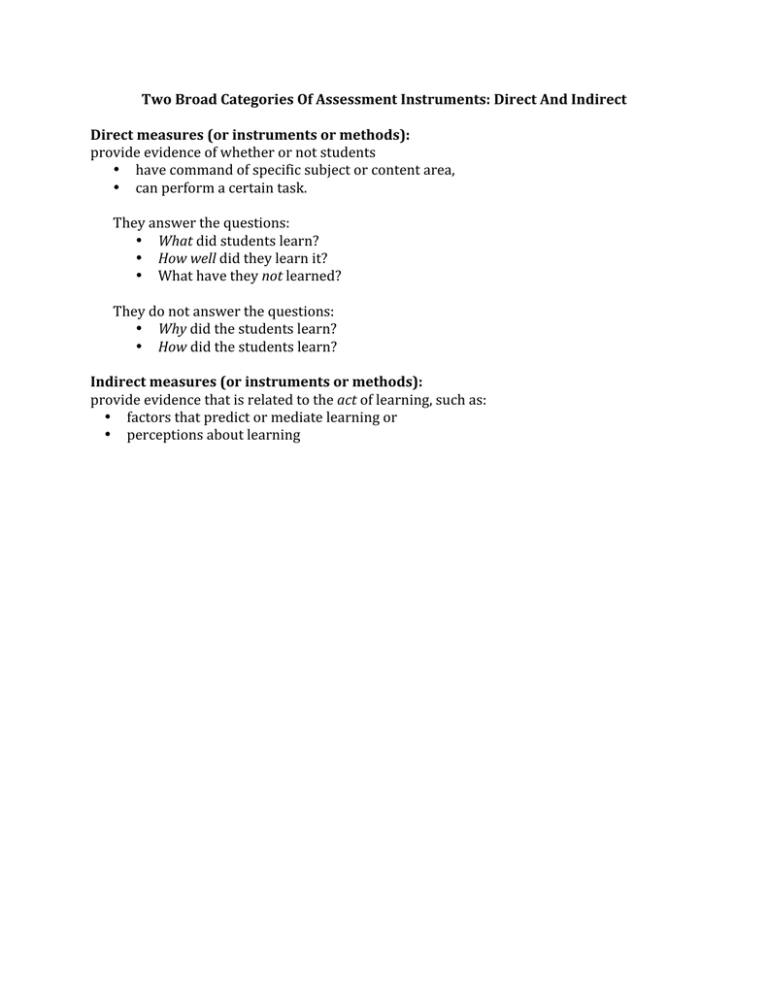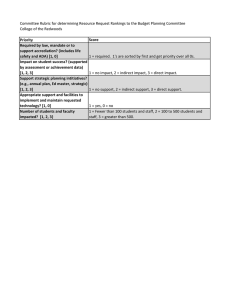Two Broad Categories Of Assessment Instruments: Direct And
advertisement

Two Broad Categories Of Assessment Instruments: Direct And Indirect Direct measures (or instruments or methods): provide evidence of whether or not students • have command of specific subject or content area, • can perform a certain task. They answer the questions: • What did students learn? • How well did they learn it? • What have they not learned? They do not answer the questions: • Why did the students learn? • How did the students learn? Indirect measures (or instruments or methods): provide evidence that is related to the act of learning, such as: • factors that predict or mediate learning or • perceptions about learning Examples of Direct and Indirect Measures of Student Learning (Course, Program, and Institutional Levels) Institutional Direct Measures • • • • • Program • • • • Performance on tests of writing, critical thinking, or general knowledge Rubric (criterion‐based rating scale) scores for class assignments in General Education, interdisciplinary core courses, or other courses required of all students Performance on achievement tests Explicit self‐reflections on what students have learned related to institutional programs such as service learning (e.g., asking students to name the three most important things they have learned in a program). Capstone projects, senior theses, exhibits, or performances Pass rates or scores on licensure, certification, or subject area tests Student publications or conference presentations Employer and internship supervisor ratings of students’ performance Indirect Measures • • • • • • • • • • • Course • • • • • • • • • • • Course and homework assignments Examinations and quizzes Standardized tests Term papers and reports Observations of field work, internship performance, service learning, or clinical experiences Research projects Class discussion participation Case study analysis Rubric (a criterion‐based rating scale) scores for writing, oral presentations, and performances Artistic performances and products Grades that are based on explicit criteria related to clear learning goals • • • • • • • Locally‐developed, commercial, or national surveys of student perceptions or self‐report of activities (e.g., National Survey of Student Engagement) Transcript studies that examine patterns and trends of course selection and grading Annual reports including institutional benchmarks, such as graduation and retention rates, grade point averages of graduates, etc. Focus group interviews with students, faculty members, or employers Registration or course enrollment information Department or program review data Job placement Employer or alumni surveys Student perception surveys Proportion of upper‐level courses compared to the same program at other institutions Graduate school placement rates Course evaluations Test blueprints (outlines of the concepts and skills covered on tests) Percent of class time spent in active learning Number of student hours spent on service learning Number of student hours spent on homework Number of student hours spent at intellectual or cultural activities related to the course Grades that are not based on explicit criteria related to clear learning goals

